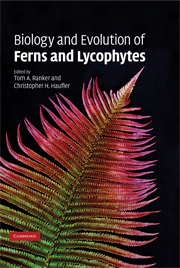Book contents
- Frontmatter
- Contents
- List of contributors
- Preface
- Acknowledgments
- Part I Development and morphogenesis
- Part II Genetics and reproduction
- Part III Ecology
- Part IV Systematics and evolutionary biology
- 12 Species and speciation
- 13 Phylogeny and evolution of ferns: a paleontological perspective
- 14 Diversity, biogeography, and floristics
- 15 Fern phylogeny
- 16 Fern classification
- Index
- References
13 - Phylogeny and evolution of ferns: a paleontological perspective
Published online by Cambridge University Press: 11 August 2009
- Frontmatter
- Contents
- List of contributors
- Preface
- Acknowledgments
- Part I Development and morphogenesis
- Part II Genetics and reproduction
- Part III Ecology
- Part IV Systematics and evolutionary biology
- 12 Species and speciation
- 13 Phylogeny and evolution of ferns: a paleontological perspective
- 14 Diversity, biogeography, and floristics
- 15 Fern phylogeny
- 16 Fern classification
- Index
- References
Summary
Introduction
Ferns traditionally have been identified as megaphyllous plants that reproduce by sporangia borne on leaves (i.e., fronds; Bower 1923; Kaplan and Groff, 1995). Although not all species have the entire set of characters, ferns typically are recognized by sporophytes that display unipolar growth (Rothwell, 1995), are dominated by fronds (Kaplan and Groff, 1995), and are devoid of secondary growth. Many have highly branched fronds, mesarch xylem maturation, and a rhizome stele that is dissected by leaf gaps. Plants that display various combinations of these features occur in the fossil record from the Middle Devonian (i.e., 390 million years ago) to the Recent, but there has been considerable systematic turnover with several prominent clades replacing one another through geological time (Rothwell, 1999). In practice, botanists have traditionally recognized as “ferns” those species that are left over after all other euphyllophytes have been removed to clades with clearly identifiable synapomorphies (Rothwell, 1999).
Up to the present, attempts to define ferns within a phylogenetic framework have met with only limited success (Figure 13.1) due to a combination of (1) limited information about many extinct ferns and fern-like plants, and (2) the restricted taxon sampling available for phylogenetic analyses that include only living species. The paleontological record of ferns is incomplete, and thus far has been sampled for only a small fraction of the available fossils (Stockey and Rothwell, 2006). This leaves us with an often confusing picture of inadequately known extinct species that can be difficult to comprehend and appreciate.
- Type
- Chapter
- Information
- Biology and Evolution of Ferns and Lycophytes , pp. 332 - 366Publisher: Cambridge University PressPrint publication year: 2008
References
- 15
- Cited by



